Vintage Austin 7 Ulster-based Special.
This is the story of how I came to buy an Austin 7, a small vintage two-seater based on Ulster and Chummy parts. Amazingly it had been tucked
away since the late 1950s, untouched, and hemmed-in within a pitch black tin shed by piles of vintage machinery and old vehicle parts. Are there are more 1920s or 1930s Austins out there like this, lying in an old garage, barn or shed, waiting to be rescued?
|
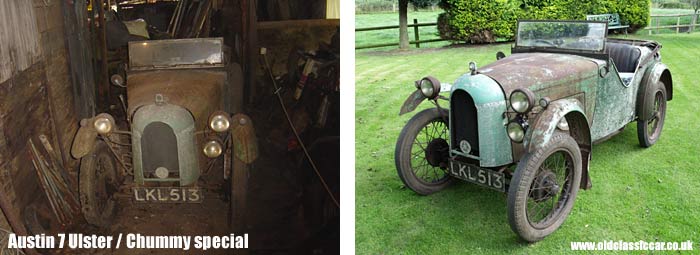
|
|
News of a "barn find" is guaranteed to get my attention, and when I heard of an "Austin 7 Ulster" that had been stashed away for 50 or 60 years,
it seemed like a good idea to follow it up. The lady who owned the car told me its story - her father, Edwin Everett, had run the Austin during the 1950s, and she remembered riding in it to school when just four years of age. The car was taken off the road in the late '50s, and parked in a tin shed, where it had lain undisturbed, in the dark, ever since.
|
|
Many different versions of the Austin 7 were produced during the car's life. The Ulster, or EA Sports as it was known by the factory, was the
sporting two-seater, available in supercharged or un-supercharged form. Many were raced at Brooklands throughout the 1930s, and many others
of the 2-300 that were built (estimated) saw some level of competitive action, whether at hillclimbs, sprints, or off-road trials. As I'd harboured an
interest in buying an Austin 7 of some description, arrangements were made to visit the lady who now owned the car.
|
|
Finding the correct house proved tricky, as despite being on a main road, it was obscured from sight by established trees and accumulated undergrowth. All I could go by was a description of the location, and the presence of a postbox that had an overgrown driveway entrance alongside it. I was early, so telephoned the owner and bided my time. A short while later, the owner arrived, opened up the entrance, and down the driveway we went, overgrown bushes on either side only just wide enough to accomodate a car.
|

|
|
I'd been told of her father's other interest, Bedford CA vans, and this became evident as we stopped a short distance from the house. There must have
been seven or eight CAs dotted around in the undergrowth, all beyond salvation, but fascinating to see nonetheless. Other vehicles were also in evidence, a Mk2 Transit dropside truck, an HC Viva, a Marina van and the decayed remains of a Ford sidevalve chassis, are the key ones that I recall. The house itself was a sight to behold - a once-grand Victorian home, surrounded by tall trees and fauna, some of which were growing through the rear corner of the building, rendering it quite precarious in places. Adjoining the house, an assortment of corrugated tin sheds, blocked in by various remnants of an engineer's collecting habits. The owner's late father, a gifted engineer, wasn't one to throw away anything that could one day be of use. As things wore out, they'd be put to one side, either for future refurbishment, or else to be used for spare parts to keep another machine going. Many of these elderly items of machinery were laid to rest against the side of the ivy-covered entrance, presumably as a form of security.
|
|
The first job was to move the clutter away from the entrance doors, and with this done the doors could be unlocked and swung open. Inside were yet more old tools, lathes, engines and even another Bedford CA, slightly better than those decaying outside but still needing a lot of work, and part-buried beneath many more old things. Torches were definitely going to be essential. Firstly we had to negotiate a path down the side of the white CA van, clambering over unidentified engine parts, ride on mowers, and the like, into another partitioned room within the tin building. In here were the first signs of Austin 7 - engines, crankcases, axles, steering columns and more were easily identifiable, along with other vehicle parts (mostly Ford 10 and some later 100E odds and ends). Over these we had to clamber, still by torchlight, until a smaller door could be reached. This had been nailed up, so took a few moments before it too could be opened, revealing whatever lay beyond.
|
Accessing and viewing the Austin by torchlight.
The next room was only just car-sized, and at first identifying the "barn find" that was stashed away inside proved tricky.
|

|
|
One glance of the back end showed that if it was an Austin 7 Ulster, it was not as it had left the factory. Clambering in a little further allowed some more inspection, although with more old things stacked on top and all around the little car, it wasn't terribly easy. The centre section of the car certainly reminded me of an Ulster, but the pointed tail usually seen on these cars had long since gone, to be replaced by a home-made booted affair, made from riveted sections of aluminium. The dash was also non-Ulster, a wooden job in which a variety of elderly gauges sat. A Manifold Pressure gauge first caught my eye, and it probably came from an aircraft after the war, alongside which sat a 90mph Cooper Stewart speedometer (Ulsters had a 100mph gauge I'm told). Another auxiliary gauge monitored the engine's oil pressure, and a vintage Renault ammeter kept an eye on the charging system. Evidently the car was something of an Austin 7 Special, built using contemporary parts.
|
|
Moving forward, the steel bonnet, with side louvres, was gingerly opened up. Slim hopes of finding a supercharged engine slipped away at this point, as the car now had a standard Austin 7 engine in it. The front axle too also looked standard, no sign of a dropped Sports axle unfortunately. The front radiator cowl also looked very much like a one-off. The impression I had then, which has since been reinforced by speaking to those who know about Austin 7s, is that an Ulster was used as a basis for building what became an Austin 7 special. The chassis looks like it came from an Austin Chummy, the body tub from an Ulster, and the bonnet and cycle wings from other places not yet identified.
|
|
It was fascinating to see this untouched little machine, tucked away for all this time. After all, it hadn't seen daylight since the year that Buddy Holly, the
Big Bopper and Ritchie Valens died in a plane crash, and Jack Brabham won his first F1 World Championship, in a Cooper Climax.
|
|
With some photos taken, as best as I could given the cramped unlit conditions, I bid my farewells and left the car's owners to consider my offer. They were keen to see the car and all the spares go as a job lot. This made sense to me too, as that way I could sort out the Austin 7 parts from the others and perhaps better understand how the car came to be built up as it was, back in the 1950s. Negotiations continued, and we struck up a deal.
|
Next, how to move the Austin out of the tin shed.
The plan was to extricate the car from it's long term home, and sort out the spare parts at a later date. The latter items were distributed in not just the various outbuildings, but also in rooms on all floors in the house, so that would have to come later.
|
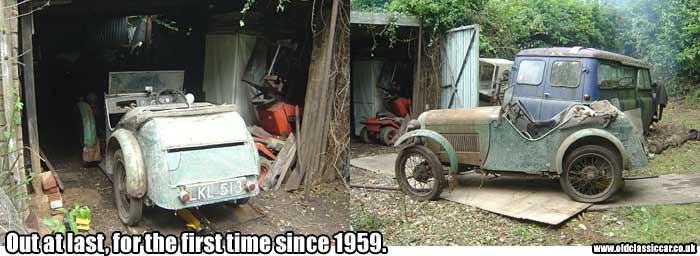
|
|
A trailer was arranged, and dad roped in to help with the pushing and shunting that would be required to get the Austin out. As expected, the Austin's brakes were seized yet a couple of the tyres still held air. The only way to move it from its cramped home was on a trolley jack under the diff, with dad levering against the front axle with a scaffold pole. The tin building didn't have a concrete base, just compacted earth, so the trolley jack could only be used on a plank of wood, and the car dragged along this, inch by inch, with the plank and jack re-positioned every few yards. The next trick was to negotiate a corner inside the building, complicated by the close presence of a very heavy lathe. Lots of jiggling and bouncing on what was a very warm day, saw the Austin turned through 90 degrees and now in line with the main entrance. It sounds quite straightforward yet took much of the afternoon. Eventually the car made it to the entrance, the sun warming its aluminium bodywork for the first time in fifty years.
|
|
More pieces of wood were lain across the grass outside, and over these the jacked-up Austin was manouevred, turning again until lined up with the trailer.The loading of the car onto the tilting trailer was quite straightforward, although the Austin's narrow track did make us wonder how well it'd sit on the bed once winched aboard. The drive home was uneventful, although because of the sticking brakes, it had to be towed off the trailer. My A40 pickup (since sold) was pressed into service, and it towed its older brother into the garage, the locked rear wheels churning up the driveway nicely.
|
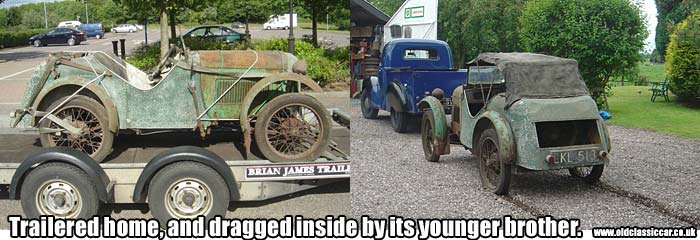
|
|
With the car safely home, it was time to consider how to go about collecting the various vintage car parts that were part of the deal. It was obvious that trying to gather them all together, and load them into a van and drive back was going to be too much for one day. The plan therefore was to go down and amass the parts into "holding areas", then return later with a suitable van. So again it was off to the Austin's former home, nearly 200 miles from our home, to organise the parts. The buildings had lots of old vehicle parts dotted around, some were of interest, others from later vehicles and too much to take on. The many many Bedford parts had been offered to a relevant club I'm told, but little interest was shown, so these ended up being scrapped, along with all the CAs that could have donated many useful parts, had the club bothered to make the effort and collect them. My focus was on the pre-war items though, and by the end of the day I'd sorted through and organised a fair amount, both from the outbuildings and also in the house. The house was full of stuff, not all car-related, and getting in some of the rooms to see what was there proved difficult at times. Various vintage radiator surrounds were located dotted about the property, Austin 7 gaskets and old gauges were sourced in other rooms, some of the gaskets simply hanging on nails in what had been a living room in the dim and distant past.
|
|
The next trip, by van, saw these parts collected and brought back home to be with the car. Some are Austin, others are not, and sometime I'll sort through everything to see what there is. There are for instance 7 or 8 aluminium crankcases, however they all appear to be standard pre-Ruby Austin 7 type, nothing sporting as I can see. However the presence of a 750 Motor Club badge on the car itself, and features I've since discovered on the car itself, suggest that maybe once upon it was used competitively. The previous owner's father though was, I'm told, dead-set against the car every being raced. Perhaps he once owned the Ulster on which this special was based, following a bump that saw the original tail damaged, and this put him off competition driving for good? Or else a different driver bent an Ulster in a race, and the special's builder bought the remains to use in his build?
|
|
More old parts have turned up since my fourth trip, when this batch of old parts was collected, so I predict another trip in the not-too-distant future.
|
Researching the 7's history.
In a bid to try and find out more about the car, I've taken it to a couple of classic and vintage gatherings. The first trip out was to a local VSCC (Vintage Sports Car Club) meeting, as a few Austin 7 owners usually turn up, and hopefully they'd be able to shed some light on the car. They confirmed my thoughts, and also suggested that the rad cowl may be from a Swallow, or at least the top section might be. Amongst the spare parts, I found two halves of an early Swallow rad surround, which do seem to line up nicely with the top curved section. The second show was a small gathering of vintage and classic cars, and the Austin 7 stood alongside an equally "patinated" Gipsy.
|
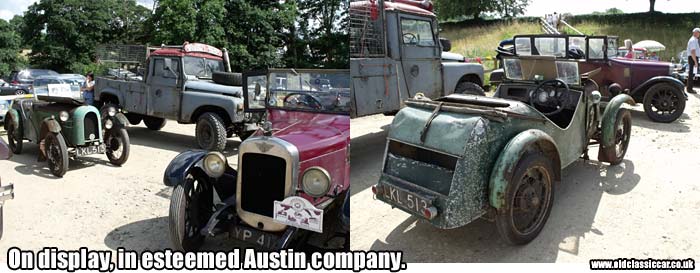
|
|
There are other things I need to research further. Firstly, a look at the bulkhead on the passenger side shows a neat panel riveted in, which looks like it is to give clearance for an exhaust that would have exited from the side of the bonnet. The Ulsters had side-exit exhausts, but they didn't need a recess letting into the bulkhead, which makes me think that in it's earlier incarnation, this car, or rather the bodytub, has seen some sporting use, probably prior to the war when it was just a few years old.
|
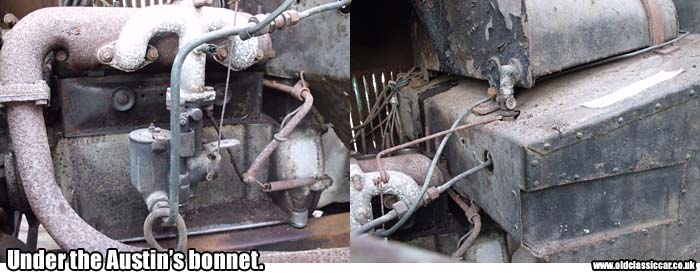
|
|
The chassis number dates the chassis to late 1928, ie a little earlier than the body, so probably came from a Chummy (perhaps the car should be named the "Chumster", after its Chummy & Ulster roots??). The aluminium body, with it's steel floor and transmission tunnel that rises up at the rear to clear the rear axle, is factory Ulster, and the remains of the cut-off rear tail are visible inside the later rear boot area. The high up position of the mudguards, when compared to the wheels, suggest that at some time perhaps the car did sit on an Ulster-type, lowered, front axle and flatter rear springs. Despite appearances, I don't think it has been used in vintage trialling.
|
|
Amongst the spares I found an Amal carb, which may also have seen service on the Austin at some point. The car is fitted with a remote gearchange. The outside handbrake is a non-factory modification too. Amongst the parts I also found a hand primer for a fuel system, this could be from the car or possibly an old motorcycle, so the jury's still out on that one. Found buried in a collapsed building were two aluminium bonnet top panels, they seem to match up with the car's scuttle, and the length seems correct, but the shape doesn't match the curvy rad cowl fitted to the car now, so may be from a different car, or else this one if it was modified for racing in the 1930s.
|

|
|
Along with the car came a spare chassis section. On it is a small plate saying "This chassis is the Property of the Austin Co. Ltd Longbridge Birmingham". I'm told that Austin 7s that were bodied from new by outside coachbuilders tended to have these plates affixed to them, so quite what this chassis was once used for is anyone's guess at the moment. It is a little later than that fitted to the car, and I'm told records for some of the slightly later 7 chassis still exist with the BMIHT so I might try getting a heritage certificate done on it. Although it'd be nice to think so, the presence of a hole in the chassis outrigger suggests it was used on a normal road car, and not an Ulster (they didn't need this hole due to its side-exiting exhaust system so I'm told).
|
|
The plan was to preserve the car 'as is' while I a) finished off some projects I was already in the middle of, and b) continue researching the little Austin, to see if any of its history, either post-war or pre-war, could be found. However, pressures of work, family commitments and other vehicles led to little work being undertaken on the Austin in the years that I owned it. In the end I sold it, along with a few other un-restored cars to try and get my workload down to a manageable level. Hopefully it'll be restored sympathetically.
|
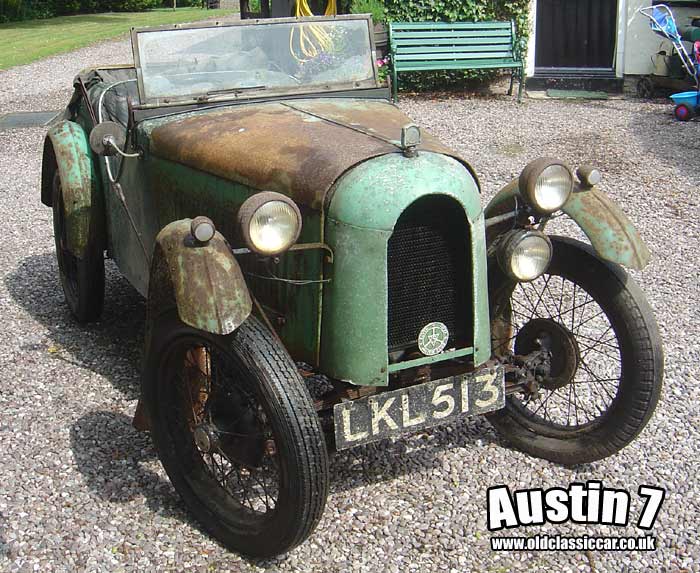
|
|
Various sections of the site include information on Austin Sevens, including various old photographs (eg chrome-rad Austin 7 saloons, later Rubys, a Gordon England 2 seater at RAF Dunmow, and various other A7 tourers), Speedex A7 tuning parts, and a Windows (XP) screensaver featuring early and late-model Austin 7s. A smart Austin 7 special photographed in S. Africa can be found here, in the vintage gallery.
|
|
Click here to see some of the other old crocks I've had over the years :-)
|













